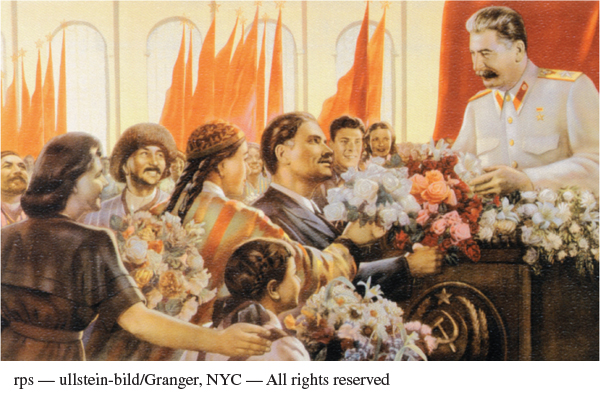A History of Western Society: Printed Page 906
A History of Western Society, Value Edition: Printed Page 868
A History of Western Society, Concise Edition: Printed Page 907
Chapter Chronology
From Lenin to Stalin
By spring 1921 Lenin and the Bolsheviks had won the civil war, but they ruled a shattered and devastated land. Many farms were in ruins, and food supplies were exhausted. In southern Russia, drought combined with the ravages of war to produce the worst famine in generations. Industrial production had broken down completely. In the face of economic disintegration, riots by peasants and workers, and an open rebellion by previously pro-Bolshevik sailors at Kronstadt, Lenin was tough but, as ever, flexible. He repressed the Kronstadt rebels, and in March 1921 he replaced War Communism with the New Economic Policy (NEP), which re-established limited economic freedom in an attempt to rebuild agriculture and industry. During the civil war, the Bolsheviks had simply seized grain without payment. Now peasant producers were permitted to sell their surpluses in free markets, and private traders and small handicraft manufacturers were allowed to reappear. Heavy industry, railroads, and banks, however, remained wholly nationalized.
The NEP was a political and economic success. Politically, it was a necessary but temporary compromise with the Soviet Union’s overwhelming peasant majority. Realizing that his government was not strong enough to take land from the peasants and turn them into state workers, Lenin made a deal with the only force capable of overturning his government. The NEP brought rapid economic recovery, and by 1926 industrial output surpassed, and agricultural production almost equaled, prewar levels.
Page 908
In 1924, as the economy recovered and the government partially relaxed its censorship and repression, Lenin died without a chosen successor, creating an intense struggle for power in the inner circles of the Communist Party. The principal contenders were Stalin and Trotsky. Joseph Dzhugashvili (joo-guhsh-VEEL-yih) — later known as Stalin (from the Russian for “steel”) — was a good organizer but a poor speaker and writer, and he had no experience outside of Russia. Trotsky, a great and inspiring leader who had planned the 1917 Bolshevik takeover and then created the victorious Red Army, appeared to have all the advantages in the power struggle. Yet Stalin won because he was more effective at gaining the all-important support of the party. Having risen to general secretary of the party’s Central Committee in 1922, he used his office to win friends and allies with jobs and promises.
Stalin also won because he was better able to relate Marxist teaching to Soviet realities in the 1920s. Stalin developed a theory of “socialism in one country” that was more appealing to the majority of party members than Trotsky’s doctrine of “permanent revolution.” Stalin argued that the Russian-dominated Soviet Union had the ability to build socialism on its own. Trotsky maintained that socialism in the Soviet Union could succeed only if a socialist revolution swept throughout Europe. To many Russian Communists, this view sold their country short and promised risky conflicts with capitalist countries. Stalin’s willingness to revoke NEP reforms furthermore appealed to young party militants, who detested the NEP’s reliance on capitalist free markets.

Ethnic Minorities in the U.S.S.R. The Soviet Union inherited the vast and diverse territories of the former Russian Empire. In this propaganda poster, titled “The Great Stalin Is the Banner of Friendship Between the Peoples of the U.S.S.R.!” the Soviet dictator receives flowers from a diverse group of Soviet citizens, including ethnic Russians and East and Central Asians. This idealized testament to peaceful coexistence within the Soviet empire masked the tensions aroused by Russian domination. How does this poster represent the relationship between Stalin and the Soviet people?
(rps — ullstein-bild/Granger, NYC — All rights reserved)
Stalin’s ascendancy had a momentous impact on the policy of the new Soviet state toward non-Russians. The Communists had inherited the vast multiethnic territories of the former Russian Empire. Lenin initially argued that these ethnic groups should have the right to self-determination even if they claimed independence from the Soviet state. In 1922, reflecting such ideas, the Union of Soviet Socialist Republics (or U.S.S.R.) was organized as a federation of four Soviet republics: the Russian Soviet Federative Socialist Republic, Ukraine, Belorussia, and a Transcaucasian republic. The last was later split into Armenia, Azerbaijan, and Georgia, and five Central Asian republics were established in the 1920s and 1930s (Map 27.1).

Figure 27.1: MAP 27.1 The Formation of the U.S.S.R. When the Bolsheviks successfully overthrew the tsarist government and won the civil war that followed, they inherited the vast territories of the former Russian Empire. Following policies instituted by Stalin, they established a Union of Soviet Socialist Republics (U.S.S.R.) that gave limited cultural autonomy but no real political independence to the Soviet republics now under Communist control.
In contrast to Lenin, Stalin argued for more centralized Russian control of these ethnic regions. His view would dominate state policy until the breakup of the Soviet Union in the early 1990s. The Soviet republics were granted some cultural independence but no true political autonomy. Party leaders allowed the use of non-Russian languages in regional schools and government institutions, but the right to secede was a fiction, and real authority remained in Moscow, in the hands of the Russian Communist Party. The Stalinists thus established a far-flung Communist empire on the imperial holdings of the former tsars.
With cunning skill, Stalin achieved supreme power between 1922 and 1927. First he allied with Trotsky’s personal enemies to crush his rival, and then he moved against all who might challenge his ascendancy, including former allies. Stalin’s final triumph came at the party congress of December 1927, which condemned all “deviation from the general party line” that he had formulated. The dictator and his followers were ready to launch the revolution from above, radically changing the lives of millions of people.

